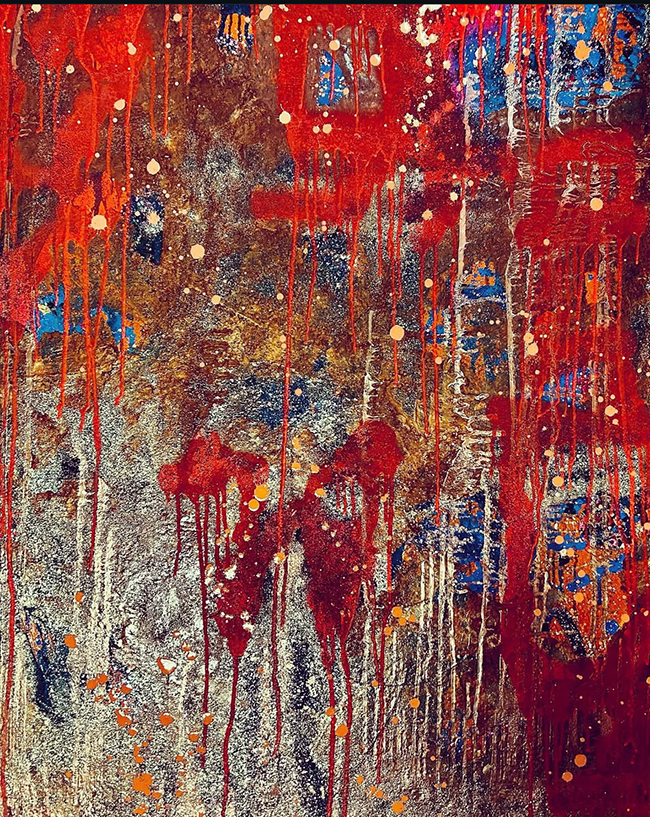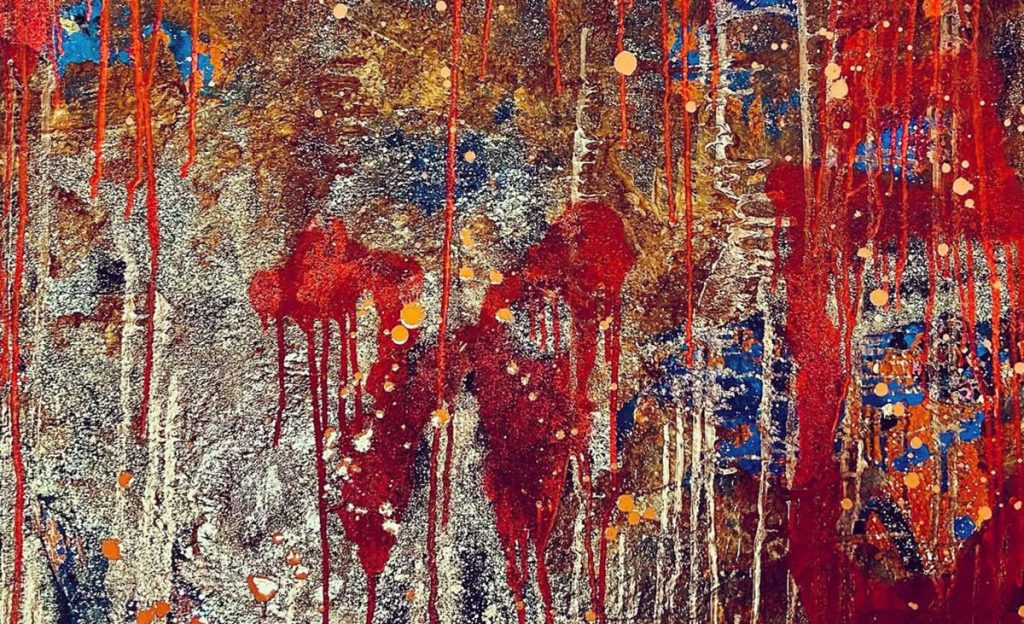Lola Szent-Gyorgyi is an Environmental Abstract Artist whose work draws its strength from the intertwined pulse of the natural and man-made world. She sees rhythm everywhere—whether in a line of branches, a city wall, or the patterns of erosion and decay. For her, this rhythm is not just visual but elemental, rooted in what she calls the Universal Design of nature. Over the past three decades, Lola has immersed herself in creative fields as varied as set design, graphic design, mechanical drafting, fine art, interior décor, fashion, textile design, and photography. This broad foundation is not an aside—it’s central to her way of making art. Each discipline sharpened a different instinct: the discipline of drafting, the flow of textiles, the balance of interiors, the immediacy of photography. Together, these influences shape her canvases, giving them both structure and spontaneity, a sense of energy contained but never restrained.

Chasing Ghosts
“Chasing Ghosts” (40” x 31”, mixed media on canvas) is one of those works where Lola Szent-Gyorgyi allows her broad vocabulary of visual references to converge. The piece is raw, nocturnal, and restless, pulling from street walls, gang markings, the red flare of danger, and the older language of cave painting.
At first glance, the canvas feels almost urban—its gestures suggest tags left in haste, a kind of coded urgency scribbled into the surface. Red asserts itself, sharp and unavoidable, a reference to blood but also to defiance. It’s the kind of red that lingers, not decorative but insistent, refusing to be ignored. For Lola, red often carries double weight: it speaks of violence but also of vitality, a reminder that life and threat are never far apart.
Beyond the red marks, there are ghostly forms rising from shadow. Shapes like vapor, half-formed figures that seem to hover between presence and absence. They are not fully drawn, not quite human, but spirit-like, rising as if from a fog or from the walls of memory. Lola often works in this space between the physical and the imagined. Here, she leans into the sense of haunting—specters born not only from the mists of night but also from histories embedded in walls, alleys, and ruins.
The reference to primitive cave painting gives the piece its anchor. There is a timelessness in the marks—simple strokes, raw symbols, silhouettes that feel scraped from stone. In this sense, “Chasing Ghosts” connects past and present: the ancient act of marking walls to communicate, to declare presence, to conjure spirits, meets the modern graffiti tag, a fast claim on space, a sign left for others to decode.
This duality—the primitive and the contemporary—creates a tension that charges the work. The ghosts could be ancestors as much as urban spirits, their whispers carried forward in spray paint instead of ochre. By linking these two worlds, Lola reminds us that the impulse to leave a mark, to signal existence, has always been part of human survival.
The canvas itself seems to breathe. The layering of media creates depth, a sense of mist curling around the shapes, of marks appearing and dissolving depending on the angle of view. This quality echoes Lola’s long practice in textile design and photography. The surface is not static—it has rhythm, a push and pull between sharpness and blur. The viewer is caught between clarity and haze, much like chasing a ghost you can never quite grasp.
There’s a darkness to the piece, but it is not hopeless. The energy is restless, even alive. Lola does not simply depict loss or fear; she leans into the vitality of the chase itself. The pursuit of meaning, the urge to confront what lingers in shadow, is part of the human condition. “Chasing Ghosts” does not resolve these tensions—it embodies them, holding them in balance on the canvas.
What makes the piece resonate is its honesty. It does not dress up its references. Street art, blood, mist, cave painting—these are raw elements. Lola doesn’t sanitize them, nor does she romanticize them. She brings them together in a way that feels both spontaneous and intentional, much like the rhythm she perceives in nature itself. Everything is connected, everything is alive, even the ghosts.
In the end, “Chasing Ghosts” is less about the ghosts themselves and more about the act of chasing—of following traces, of recognizing marks left by others, of moving through the shadows of memory and history. It’s an artwork that reminds us that what is gone is never entirely gone, and that what we pursue often tells us more about ourselves than about what we are chasing.

